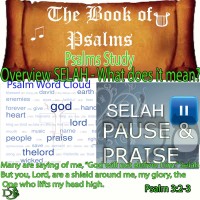

Read: Psalm 3:2-3 |
Selah!
“Amen” and “Hallelujah” are instantly recognizable regardless of your native tongue. I suggest that the word “Selah” could and should be in their company.
“Selah” appears in the Bible 74 times exceeding the 24 times that word “Hallelujah” appears. Obviously, simply counting appearances of a word in the Bible by itself carries little significance. However, Christ himself said, “It Is easier for heaven and earth to disappear than for the least stroke of a pen to drop out of the Law”. Thus, if we tune in and recognize the placement of Selah – a musical notation – particularly within the song sheets of Psalms, I believe we can find eternal significance.
What does Selah mean?
Strong’s concordance tells us that Selah (seh’-law) is a verb and means to lift up, exalt. Like Amen, it is transliterated from Hebrew.
Selah is thought to be derived from salah, “to pause.” From salah, comes the belief that selah is a musical notation signifying a rest (silence) to the singers and/or instrumentalists who performed the Psalms.
If we combine the word selah “exalt and lift up” with the root word salah “pause”, we create a working definition that Selah means to “Pause and Praise”.
Crescendos happen after “Selah” – Pause and Praise
The placement of the verb Selah is very intentional, much like “Amen”. Author Jerry Mayday, noted that where Selah appears within a Psalm, on average it occurs roughly two times within that Psalm.
Various sources suggest that Selah offers us a transitional point where we can look back at the verse prior to Selah. We pause at this point. The next verse contains the crescendo. After the pause, we are now prepared to Praise God for what He has done, is about to do or is doing.
Let’s look at Psalms 3:2-3 for an example of Pause and Praise:
2Many are saying of me, “God will not deliver him.” Selah
3But you, Lord, are a shield around me, my glory, the One who lifts my head high.
In verse 2, David is restating a commonly held belief and concern. He then pauses. In verse 3, now his whole tone and tenor changes as he lifts his voice to praise God for being the shield around him who “will” deliver him despite the concerns in the preceding verse. As we examine each of the couplets before and after each Selah in Psalms, we find this pattern to hold true (except where Selah is the last word in a Psalm).
The only other book of the Bible that contains Selah is Habakkuk. In Habakkuk’s prayer in chapter 3, Selah inspires us to pause and praise God for His mercy, power, sustaining grace, and sufficiency.
What you do during the pause matters!
What happens during a pause matters! When I feel depressed, oppressed and repressed, I not only need to learn to pause but also to turn to God. At that point, I need to be still and allow God to move and remind me of His past mercy and grace. I need to rest in Him and allow Him to work it out. Only then, can I go forward to the next verse in my life. At that point, God will strike the right chords and play the right notes that open windows of blessings for me.
Selah
In our sound-soaked world, too many don’t take the time to pause. Pausing allows us to internalize, reflect and absorb what God has done and what He is doing in our lives. It has been said that “Silent meditation is still a gateway to the presence of God”.
Obviously, to stay paused invites slothfulness, which is a sin. We are to pause, but on the other side of that we should praise and then prepare to work toward God’s plans for our lives. The pause and praise serve to fuel our heart, mind and soul to continue the great work we have been appointed to do.
Questions:
1. Discover –
A. How had you approached “Selah” in the past? Did you read right over it or were you curious about it?
B. When you are in the middle of a situation, do you pause at all to allow God to speak to you?
2. Develop –
A. Read Psalm 3 and Psalm 4, they are called the Morning and Evening Psalms. Look at the verses before each Selah. Can you relate to the challenges that David felt?
B. Read the verse after each Selah in Psalm 3 and 4, do you see the pattern of a transformative moment of pause and praise.
3. Demonstrate –
A. While we are called to pause and praise, we are also to move past the pause to active Praise and preparation to do the work God has called us. Does your life exhibit a pattern of pause-praise and then active praise and preparation? Ask your prayer partner for their opinion.
Psalms
Overview – Part 1 – Why, What and Who
Overview – Part 2 – Poetry, Prayer and Power
Overview – Part 3 – 5 Books in One
Overview – Part 4 – The significance of Selah
Book 1
Psalm 1
Psalm 2
Psalm 3 and 4
